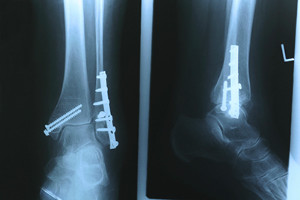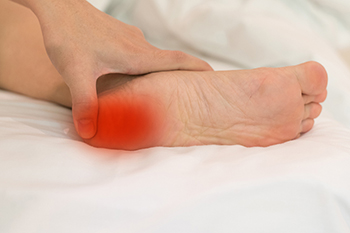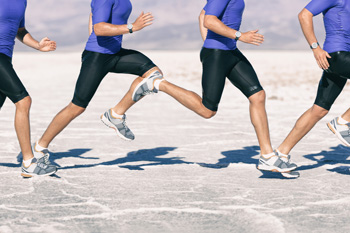Items filtered by date: October 2021
What Are the Different Types of Fractures?
There are many ways to break a bone. Acute fractures occur suddenly and are caused by direct trauma. Stress fractures are small and caused by repetitive damage from overuse. Fractures can be closed or open. In a closed or simple fracture, the skin remains intact. In an open or compound fracture, the bone breaks the surface of the skin. Fractures can further be categorized based on how the bone is broken. A transverse fracture means that the bone is broken in a straight line, while an oblique fracture means that the bone is broken diagonally. A spiral fracture circles around the bone. A comminuted fracture is when the bone breaks into more than one piece. An avulsion fracture is when a ligament or tendon tears and pulls a small piece of bone away with it. If you have broken a bone in your feet or ankles, please seek the care of a podiatrist.
Sports related foot and ankle injuries require proper treatment before players can go back to their regular routines. For more information, contact Leonora Fihman, DPM of California. Our doctor can provide the care you need to keep you pain-free and on your feet.
Sports Related Foot and Ankle Injuries
Foot and ankle injuries are a common occurrence when it comes to athletes of any sport. While many athletes dismiss the initial aches and pains, the truth is that ignoring potential foot and ankle injuries can lead to serious problems. As athletes continue to place pressure and strain the area further, a mild injury can turn into something as serious as a rupture and may lead to a permanent disability. There are many factors that contribute to sports related foot and ankle injuries, which include failure to warm up properly, not providing support or wearing bad footwear. Common injuries and conditions athletes face, including:
- Plantar Fasciitis
- Plantar Fasciosis
- Achilles Tendinitis
- Achilles Tendon Rupture
- Ankle Sprains
Sports related injuries are commonly treated using the RICE method. This includes rest, applying ice to the injured area, compression and elevating the ankle. More serious sprains and injuries may require surgery, which could include arthroscopic and reconstructive surgery. Rehabilitation and therapy may also be required in order to get any recovering athlete to become fully functional again. Any unusual aches and pains an athlete sustains must be evaluated by a licensed, reputable medical professional.
If you have any questions please feel free to contact our offices located in Encino and Brentwood, Los Angeles, CA . We offer the newest diagnostic and treatment technologies for all your foot and ankle needs.
What Is Heel Fat Pad Syndrome?
The heels of our feet are cushioned by fatty tissues that form a heel pad. This structure acts as a shock absorber, protecting our heel bones from injury. Acute or chronic trauma to the foot and aging can both wear away the heel pad, causing deep, bruise-like pain. People who are older or obese, and those who have rheumatoid arthritis or receive corticosteroid injections into the feet are at an increased risk of developing this condition. Treatment for heel fat pad syndrome is typically conservative and involves resting and icing the affected foot, wearing more comfortable shoes or orthotics, and taking non-steroidal anti-inflammatory drugs to reduce pain. If you are experiencing heel pain, it is suggested that you seek the care of a podiatrist.
Many people suffer from bouts of heel pain. For more information, contact Leonora Fihman, DPM of California. Our doctor can provide the care you need to keep you pain-free and on your feet.
Causes of Heel Pain
Heel pain is often associated with plantar fasciitis. The plantar fascia is a band of tissues that extends along the bottom of the foot. A rip or tear in this ligament can cause inflammation of the tissue.
Achilles tendonitis is another cause of heel pain. Inflammation of the Achilles tendon will cause pain from fractures and muscle tearing. Lack of flexibility is also another symptom.
Heel spurs are another cause of pain. When the tissues of the plantar fascia undergo a great deal of stress, it can lead to ligament separation from the heel bone, causing heel spurs.
Why Might Heel Pain Occur?
- Wearing ill-fitting shoes
- Wearing non-supportive shoes
- Weight change
- Excessive running
Treatments
Heel pain should be treated as soon as possible for immediate results. Keeping your feet in a stress-free environment will help. If you suffer from Achilles tendonitis or plantar fasciitis, applying ice will reduce the swelling. Stretching before an exercise like running will help the muscles. Using all these tips will help make heel pain a condition of the past.
If you have any questions please contact our offices located in Encino and Brentwood, Los Angeles, CA . We offer the newest diagnostic and treatment technologies for all your foot and ankle needs.
Abnormal Gaits
An abnormal gait is a dysfunctional walking pattern. It typically occurs due to biomechanical problems win the feet and ankles. In a normal gait, the feet both spend roughly an equal amount of time in contact with the ground. Many patients complain of a painful (antalgic) gait. This type of gait is usually due to a foot or ankle injury. The patient avoids bearing weight on the injured foot, resulting in an altered gait with shorter strides and an inequality in the amount of time each foot spends in contact with the ground (with the injured foot on the ground less). A high steppage gait is a walking pattern characterized by bending the knee more than is normal while walking. Patients do this to compensate for weak anterior compartment muscles, which can cause their foot to drop or slap onto the ground. If you have an abnormal gait, it is strongly suggested that you see a podiatrist for diagnosis and treatment.
If you have any concerns about your feet, contact Leonora Fihman, DPM from California. Our doctor can provide the care you need to keep you pain-free and on your feet.
Biomechanics in Podiatry
Podiatric biomechanics is a particular sector of specialty podiatry with licensed practitioners who are trained to diagnose and treat conditions affecting the foot, ankle and lower leg. Biomechanics deals with the forces that act against the body, causing an interference with the biological structures. It focuses on the movement of the ankle, the foot and the forces that interact with them.
A History of Biomechanics
- Biomechanics dates back to the BC era in Egypt where evidence of professional foot care has been recorded.
- In 1974, biomechanics gained a higher profile from the studies of Merton Root, who claimed that by changing or controlling the forces between the ankle and the foot, corrections or conditions could be implemented to gain strength and coordination in the area.
Modern technological improvements are based on past theories and therapeutic processes that provide a better understanding of podiatric concepts for biomechanics. Computers can provide accurate information about the forces and patterns of the feet and lower legs.
Understanding biomechanics of the feet can help improve and eliminate pain, stopping further stress to the foot.
If you have any questions please feel free to contact our offices located in Encino and Brentwood, Los Angeles, CA . We offer the newest diagnostic and treatment technologies for all your foot and ankle needs.
Heel Stretches for the Sole
 The plantar fascia is a ligament that runs along the bottom of each foot, connecting the heel bone to the toes. When this ligament is injured or inflamed, the result is usually heel and arch pain. One way to prevent or relieve tension and pain in the heel, arch, and sole of the foot is by stretching. To stretch the plantar fascia and relieve tightness under the foot, you can do a foot pull. Sit with one leg crossed over the other, then grab all of your toes and pull them as a unit back towards your shin, until you feel a pull in the bottom of your foot. Hold for 10 seconds and repeat 10 times. To massage the plantar fascia, roll a tennis ball forward and back with the bottom of your foot for 5-10 minutes a day. To learn more about plantar fascia stretches, please consult with a podiatrist.
The plantar fascia is a ligament that runs along the bottom of each foot, connecting the heel bone to the toes. When this ligament is injured or inflamed, the result is usually heel and arch pain. One way to prevent or relieve tension and pain in the heel, arch, and sole of the foot is by stretching. To stretch the plantar fascia and relieve tightness under the foot, you can do a foot pull. Sit with one leg crossed over the other, then grab all of your toes and pull them as a unit back towards your shin, until you feel a pull in the bottom of your foot. Hold for 10 seconds and repeat 10 times. To massage the plantar fascia, roll a tennis ball forward and back with the bottom of your foot for 5-10 minutes a day. To learn more about plantar fascia stretches, please consult with a podiatrist.
Stretching the feet is a great way to prevent injuries. If you have any concerns with your feet consult with Leonora Fihman, DPM from California. Our doctor will assess your condition and provide you with quality foot and ankle treatment.
Stretching the Feet
Being the backbone of the body, the feet carry your entire weight and can easily become overexerted, causing cramps and pain. As with any body part, stretching your feet can serve many benefits. From increasing flexibility to even providing some pain relief, be sure to give your feet a stretch from time to time. This is especially important for athletes or anyone performing aerobic exercises, but anyone experiencing foot pain or is on their feet constantly should also engage in this practice.
Great ways to stretch your feet:
- Crossing one leg over the others and carefully pull your toes back. Do 10-20 repetitions and repeat the process for each foot
- Face a wall with your arms out and hands flat against the wall. Step back with one foot and keep it flat on the floor while moving the other leg forward. Lean towards the wall until you feel a stretch. Hold for 30 seconds and perform 10 repetitions for each foot
- Be sure not to overextend or push your limbs too hard or you could risk pulling or straining your muscle
Individuals who tend to their feet by regular stretching every day should be able to minimize foot pain and prevent new problems from arising.
If you have any questions, please feel free to contact our offices located in Encino and Brentwood, Los Angeles, CA . We offer the newest diagnostic and treatment technologies for all your foot care needs.




